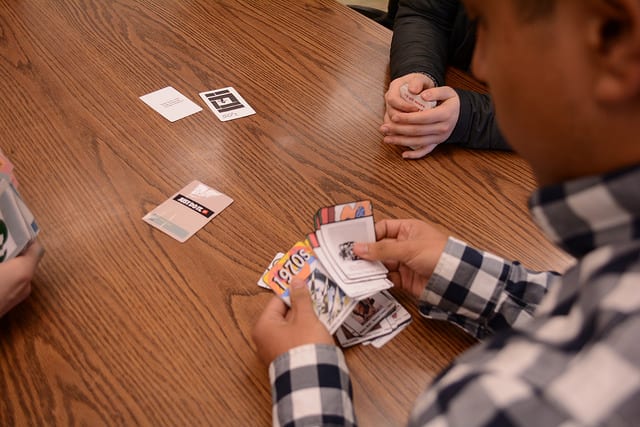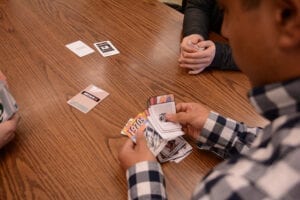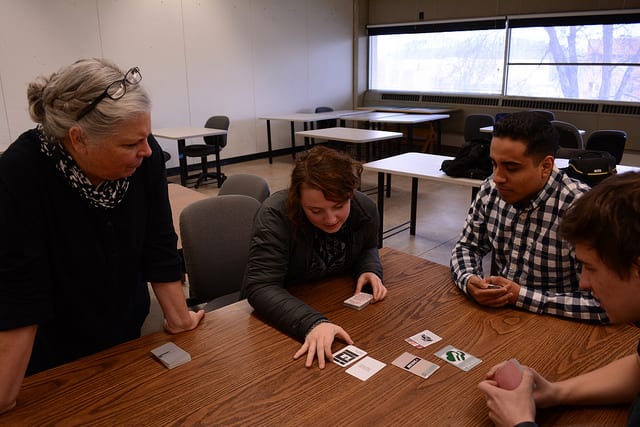TNJN Spotlight: The Test is in the Cards

The card game creates a test for students to critically think rather than just memorize a bunch of facts. Photo by Ryan McGill.
You are entering your first day in Art 150, “The Idea of Design,” and are looking over your syllabus. Except this isn’t an ordinary syllabus. This outline contains something you aren’t quite used to: your tests consist of a card game.

Rather than memorizing a bunch of names and pictures and regurgitating it onto a piece of paper every month, this game pits you against your classmates and fuels the competitor inside you.
“None of these questions have one right answer; everything is open to interpretation,” Carolyn Staples, a professor of art at the University of Tennessee who created the game, said. “All of a sudden they start making these connections, whereas it kind of feeds back into that right answer.”
Staples created the game after seeing the “MetaGame,” a term used to define any game strategy which uses external factors to affect the game, or goes beyond the supposed limits or environment set by the game, at a convention in the summer of 2012. At the time, she was teaching a small summer course and used those students to help develop what has become a central part of the course.
The game is simple. Students create cards that have a picture of a piece of artwork or design that they have learned about in class and information that includes the work title, brand name, and even quotes so that they will remember what makes each piece important. They are given a mat, which includes spaces for the cards and lines where students write their arguments. One student acts as a judge and picks which argument is better in the event of a stalled match.
Staples deals the questions as the students try to pair the artwork with whatever question is being asked. Once both cards are drawn, students are asked to explain their choice and argue against their competitor. The winning argument wins the round.
“None of the students said that the game was fun like World of Warcraft or Pokemon, but it expanded their understanding in the information, and it made them understand how to start thinking like a designer,” Staples said. “One of the things we talk about is how to metamorphisize yourself from a student into a designer because you have to take charge, make choices, and make mistakes.”

The students never find the game to be a chore, let alone a test, they said. They love having the ability to discuss what they were thinking in their choice and to find that the ability to explain themselves is a tool that comes in handy.
“Sometimes we know what we want to say. We think it but don’t always verbalize it, so this definitely helps,” Allen Minecci, a junior graphic design major, said.
“Specifically, these questions are geared towards conversation, so sometimes we wouldn’t come up with these questions,” added Brayan Zavala, a junior graphic design major. “Having that guidance and even having to talk about work that isn’t ours allows us to see different things.”
The ability to use both convergent and divergent thinking is important to Staples, and was one of the reasons she developed the game in the first place. She said that having a typical lecture made her feel as if she was just implanting what she thought into the students’ brains and they were unable to retain anything. Through the game, though, students develop their own opinions on different designers.
“The fact that you have to be able to do both (convergent and divergent thinking) to be successful as a designer, and most likely both to be successful as a creative person, that’s probably the key to why the game works well,” Staples said.
This divergent way of taking a test creates something that benefits students outside of the classroom. This skill of thinking on your feet and being able to make a decision with large consequences relates to reality when students are putting down cards that turn into their final grades.
Staples said the grades students receive on the test don’t always stick. She said one of the things that works best with this method is that students learn more, realize the mistakes they made before, and find new ways to solve and fix what they did during the first attempt at the test.
“If you fail and own up to it is as valuable as doing something right the first time,” Staples said. “It doesn’t matter who wins or loses the battle.”




